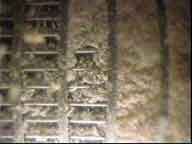Contents
- 1. Low-yielding domestic water wells
- 2. Potential health effects associated with low-yielding wells
- 3. Options for correcting low yield
- 4. References
Low-yielding domestic water wells
The objective of groundwater resource development is to design and construct a well capable of yielding a pumping rate compatible with the needs of the well owner’s intended use. Well yield is generally defined as the rate at which a well can be pumped while ensuring that the water level does not drop below the pump intake. It is reported as gallons per minute (gpm). Well yield is highly dependent on the characteristics of the aquifer, the construction of the well, and the maintenance of the well to assure long-term sustainability of yield.
Aquifer characteristics can vary between highly porous and transmissive sands to low-yielding clays and hard rock. Wells completed in more porous, saturated geologic materials routinely result in high-yielding wells. Wells completed in less porous clays and bedrock can retard groundwater flow to less than 5 gpm.
Well construction is important when optimizing yield. The screened portion of the well allows for the movement of water into the well while reducing the transport of silt and sands. An improperly sized screen (slots in the screen too large or too small) could allow sediment to clog the well and grit to damage the pump. A submersible pump that is too shallow could draw down water levels too quickly. This requires the pump to cycle on and off repeatedly as the water table rises and falls, often damaging the pump. If water table elevations drop after initial well construction, well yield will decline.

A clogged well screen
The development of scale within the well and screen is the most common cause of a reduction in well yield. Similar to the deposits found inside a tea kettle, scale is the hard residue that coats the inside of pipes and well screens as the result of precipitation of minerals composed of calcium and magnesium carbonates. Naturally occurring iron bacteria can plug the pores in the aquifer and the opening of the well screen. The bacteria produce accumulations of bioslime within the well and increase the rate of scale precipitation, not unlike plaque buildup on your teeth. The combined effect of the growth of slime and precipitated minerals has been reported to reduce well yield by 75 percent within a year of well operation in some locations (Johnson Division, 1972).
Potential health effects associated with low-yielding wells
Low-yielding wells are likely to cycle on and off to meet water needs. Rapid and repeated water level changes in the area of the well screen allow for the introduction of oxygen in the aquifer. Changes in aquifer geochemistry can occur when water-saturated geologic materials are exposed to oxygen, and this can result in naturally occurring minerals dissolving into the groundwater. If the aquifer material includes arsenic minerals, an increase in dissolved arsenic may occur (Uhlman, 2008).
In addition to the potential for loss of well yield, bioslime accumulation may allow for the growth of bacteria that can become a serious health concern. E. coli bacteria is the most common bacteria encountered in domestic wells and can originate from naturally occurring bacteria found in the soils. But the most common source of fecal E. coli in water well systems is an adjacent septic system. In regions of warm groundwater (southwestern United States) an overgrowth of bacteria in a domestic well can become a food source for other organisms, such as the amoeba N. fowleri (Artiola & Uhlman, 2009). Domestic wells should be tested annually for E. coli to assure drinking water standards are met.
Options for correcting low yield
Wells constructed in low-yielding aquifers are candidates for well deepening and pump lowering if water table elevations have dropped. Open-borehole wells, such as those constructed in bedrock, may exhibit increased yield if fractured or fracked. Hydro-fracking consists of sealing portions of the well and increasing the pressure sufficiently within the borehole to fracture the rock. Increasing the number and frequency of fractures around the borehole allows for the interception of a greater number of water-bearing fractures and may increase yield.
Shock chlorination of a well exhibiting elevated bacterial contamination removes bioslime that may be plugging the well. Care should be taken to adequately flush the well system after shock chlorination because the introduction of chlorine can change the geochemisty of the aquifer and induce mobilization of naturally occurring minerals, such as arsenic and lead.
Anecdotal reports of well owners have suggested limited success with the introduction of dry ice into the well. As the carbon dioxide (CO2) off-gases from the dry ice, the water becomes more acid, which dissolves some of the carbonate-based scale and lowers the bacterial count. The agitation of the bubbling dry ice in the borehole is also assumed to remove some particulate scale. Larger municipal wells are beginning to design large-capacity water well systems to use pressurized CO2 gas to sanitize well systems. The downside of the use of CO2 is the acidification of the water, which increases pipe corrosion.
Surging and scrubbing the interior of the well piping and screen is the most efficient means by which to increase well yield after scale formation. A licensed pump installer mobilizes a pump rig over the well, removes the pump and any interior plumbing, and scrubs the well with equipment similar to a large bottle brush. It is recommended that any pump maintenance activity that allows for open access to the well should include well surging and scrubbing to remove scale, slime, and other particulates from the domestic well.
References
Most of this text was adapted from: Artiola, J. & Uhlman, K. (2009). Arizona Well Owners’ Guide to Water Supply. Access online: http://www.wellownerhelp.org/intro.html
Johnson Division. (1972). Groundwater and Wells. Second Printing. Edward E. Johnson Inc. Universal Oil Products Co., Saint Paul, Minnesota.
Uhlman, K. (2008). Arsenic in Arizona Ground Water — Source and Transport Characteristics. Access online: http://cals.arizona.edu/pubs/water/az1453.pdf
